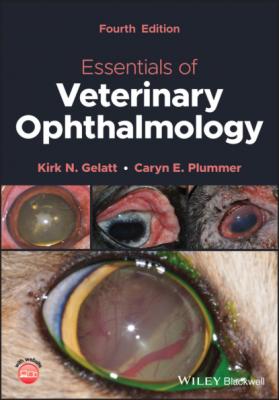Essentials of Veterinary Ophthalmology. Kirk N. Gelatt
Чтение книги онлайн.
Читать онлайн книгу Essentials of Veterinary Ophthalmology - Kirk N. Gelatt страница 30

In the feline orbit, the processes of the frontal and zygomatic bones extend a great deal more toward one another, resulting in a shortened supraorbital ligament (Figure 1.5b). There is limited orbital space in cats. In animals with enclosed orbits, closure of the temporal side of the orbit is accomplished by union of the zygomatic process of the frontal bone with the frontal process of the zygomatic bone. In the horse, the zygomatic process of the temporal bone intervenes between these two and completes the orbital rim (Figure 1.6).
Within the orbit, various foramina and fissures provide osseous pathways for blood vessels and nerves to pass from the cranial cavity and alar canal into the orbital region (Table 1.5). Those foramina of rather constant position in domestic animals are the rostral alar, ethmoidal, lacrimal, orbital, ovale, optic, rotundum, and supraorbital. Other foramina closely related to the orbital structures are within the pterygopalatine region, and these are the maxillary, caudal palatine, and sphenopalatine. The orbital foramen is elongated in most domestic animals, except the horse; therefore, it is referred to as the orbital fissure. In cattle, the orbital fissure and foramen rotundum are typically fused to form the foramen orbitorotundum.
Orbital Fascia
The orbital fascia consists of a thin, tough connective tissue lining that envelops all the structures within the orbit, including the bony fossa itself. This fascia consists of three anatomical components: the periorbita, Tenon's capsule or fascia bulbi, and the EOM fascial sheaths (Figure 1.7). Orbital surgery is usually confined within these fascial tissues or beneath it.
Figure 1.5 (a) Canine orbit. (b) Feline orbit. Bones of the orbit: frontal (F), lacrimal (L), maxilla (M), sphenoid (S), temporal (T), and zygomatic (Z). Orbital foramina: rostral alar (A), ethmoidal (E), optic (Op), and orbital fissure (Or).
Figure 1.6 Equine orbit. Bones of the orbit: frontal (F), lacrimal (L), sphenoid (S), temporal (T), and zygomatic (Z). Orbital foramina: rostral alar (A), ethmoidal (E), optic (Op), orbital fissure (Or), and supraorbital (So).
The periorbita is a conically shaped, fibrous membrane that lines the orbit and encloses the globe, EOMs, blood vessels, and nerves. The apex of the periorbita is located where the optic nerve exits the orbit and continuous with the dural sheath of the optic nerve. In the orbit, it is thin, attaches firmly to the orbital bones, and forms their periosteum. In the dog, the periorbita does not always fuse with the periosteum of the frontal and the sphenoid bones. In animals with an incomplete lateral orbital wall, the periorbita is thicker laterally next to the orbital ligament. Anteriorly, in the dorsolateral part of the orbit, the periorbita separates and surrounds the lacrimal gland. At the orbital rim, it divides into one part becoming continuous with the periosteum of the facial bones and the other, that is, the septum orbitale, merging with the eyelids and becoming continuous with the tarsal plates (the fibrous sheet in the eyelids). Within the periorbital tissue of carnivores (dogs and cats), smooth muscle has been observed along the lateral wall of the orbit, portions of the roof and floor of the orbit, and next to the periosteal lining of orbital bones, and contraction of the muscle has been produced by stimulation of the cervical sympathetic nerve trunk and results in forward movement of the globe.
Table 1.5 Foramina and associated nerves and blood vessels.
| Foramen or fissure | Species | Associated nerves and vessels |
|---|---|---|
| Alar, rostral | Canine, equine, feline | Maxillary artery and nerve |
| Ethmoidal (one or more) | All species | Ethmoidal vessels and nerve |
| Orbital | Canine, equine, feline | Abducens, oculomotor, ophthalmic, and trochlear nerves |
| Orbitorotundum | Bovine | Cranial nerves III–IV, retinal and internal maxillary arteries |
| Optic | All species | Optic nerve, internal ophthalmic artery |
| Rotundum | Canine, equine, feline | Maxillary nerve |
| Supraorbital | Bovine, canine, equine (feline variable) | Supraorbital vessels and nerve |
| Caudal palatine | All species | Major palatine vessels and nerve |
| Maxillary | All species | Infraorbital vessels and nerve |
| Sphenopalatine | All species | Sphenopalatine vessels and pterygopalatine nerve |
Figure 1.7 Divisions of orbital fascia: muscle fascia, periorbita, orbital septum, and Tenon's capsule.
Tenon's capsule (fascia bulbi) is connective tissue on the outer aspect of the sclera. Tenon's capsule is separated from the sclera by a narrow, cleft‐like space filled with loose connective tissue, Tenon's space. Tenon's capsule is attached to the sclera near the corneoscleral junction (i.e., limbus), and it becomes continuous with the fascia surrounding the EOMs. The fascial sheaths of the EOMs are dense, fibrous membranes loosely attached to the muscles with fine trabeculae of connective tissue. These sheaths are continuous with, or reflections of, Tenon's capsule, but they are not always considered part of it.
Extraocular Muscles and Orbital Fat
Three sheets of orbital fascia are separated by orbital fat. Orbital fat fills the dead space in the orbit and acts as a protective cushion for the eye. The amount of orbital fat varies between individuals and to a greater extent between species. The color of orbital fat ranges from white to yellow. Some animals, including birds and many reptiles, have very little orbital fat. When the retractor oculi muscle contracts, orbital fat can displace the glandular tissue associated with the nictitating membrane (NM), resulting in its passive movement over the cornea.
The